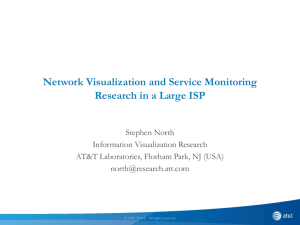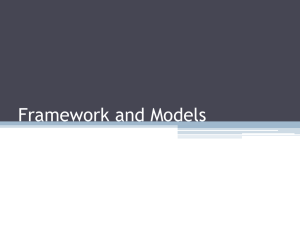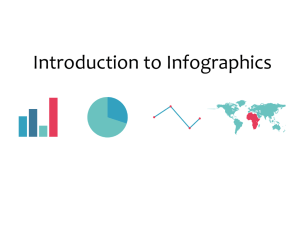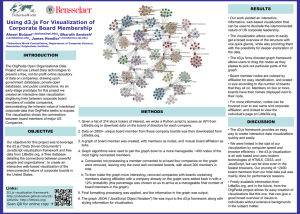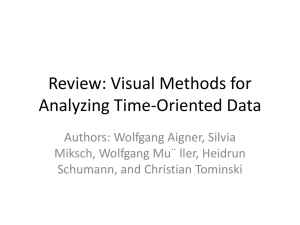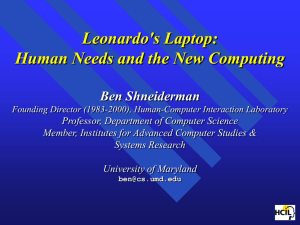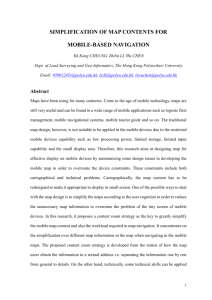Visualization Basics
advertisement
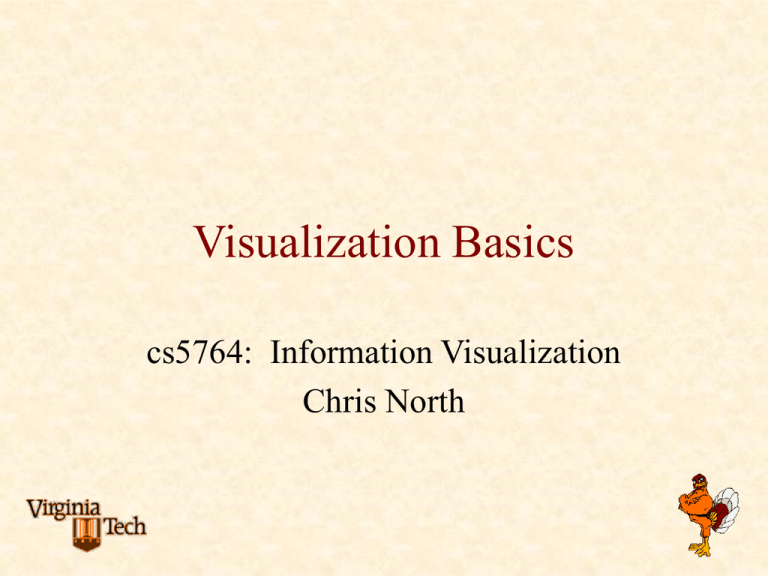
Visualization Basics cs5764: Information Visualization Chris North Project • Milestones: • Team: choose team (due Wed!) • Design Concept & Presentation: problem, lit. review, design, schedule (4 weeks) • Formative Eval & Initial Impl • Final presentation: final results • Final paper: publishable? To Do … • • • • • Hand in HW1 now Read: CMS chapter 1 handout (pg 17-end) Read: Claims analysis handout HW 2, due next Wed: MultiD Vis Tools Paper next wed: “Parallel Coordinates”, Inselberg • vidhya • Get going on Project! 3 weeks • Wed: Go to Kent Square suite 318, GigaPixel Display Review • What is the purpose of visualization? • How do we accomplish that? Basic Visualization Model Goal Data transfer Data Insight (learning, knowledge extraction) Method Data transfer Data Insight Map: data → visual Visual transfer Visualization (communication bandwidth) ~Map-1: visual → data insight Visual Mappings Data Visual Mappings must be: • Computable (math) visual = f(data) Map: data → visual • Comprehensible (invertible) data = f-1(visual) • Creative! Visualization PolarEyes Visualization Pipeline tas k Raw data (information) Data transformations Data tables Visual structures Visual mappings Visualization (views) View transformations User interaction Data Table: Canonical data model • Visualization requires structure, data model • (All?) information can be modeled as data tables Data Table Attributes (aka: dimensions, variables, fields, columns, …) Values Data Types: •Quantitative •Ordinal •Categorical •Nominal Items (aka: tuples, cases, records, data points, rows, …) Attributes • Dependent variables (measured) • Independent variables (controlled) ID Year Length Title 0 1986 128 Terminator 1 1993 120 T2 2 2003 142 T3 … … … … Data Transformations • Data table operations: • Selection • Projection • Aggregation – r = f(rows) – c = f(cols) • • • • Join Transpose Sort … Visualization Pipeline tas k Raw data (information) Data transformations Data tables Visual structures Visual mappings Visualization (views) View transformations User interaction Visual Structure • Spatial substrate • Visual marks • Visual properties Visual Mapping: Step 1 1. Map: data items visual marks Visual marks: • • • • • Points Lines Areas Volumes Glyphs Visual Mapping: Step 2 1. Map: data items visual marks 2. Map: data attributes visual properties of marks Visual properties of marks: • • • • • • Position, x, y, z Size, length, area, volume Orientation, angle, slope Color, gray scale, texture Shape Animation, blink, motion Example: Spotfire • Film database • Film -> dot – – – – – Year x Length y Popularity size Subject color Award? shape Visual Mapping Definition Language • Films dots • • • • • Year x Length y Popularity size Subject color Award? shape E.g. Linear Encoding • year x yearmin xmin x – xmin xmax – xmin = year x year – yearmin yearmax – yearmin yearmax xmax The Simple Stuff • Univariate • Bivariate • Trivariate Univariate • • • • Dot plot Bar chart (item vs. attribute) Tukey box plot Histogram Bivariate • Scatterplot • Trivariate • 3D scatterplot, spin plot • 2D plot + size (or color…) The Challenges? • • • • • • • • • evaluate or compare designs? Effectiveness? Data transforations, whats the right data table? More data, multidimensional Too many dots, limited space Choosing which data? Semantics System limitations Visualization Design HCI Design Process 1. Analyze 2. Design • Iterative, progressively concrete 3. Evaluate HCI UI Evaluation Metrics • User learnability: • Learning time • Retention time • User performance: *** • • • • Performance time Success rates Error rates, recovery Clicks, actions • User satisfaction: • Surveys Not “user friendly” Measure while users perform benchmark tasks Visualization Design • Analyze problem: • Data: schema, structures, scalability • Tasks/insights • Prioritize tasks and data attributes • Design solutions: • • • • • • Data transformations Mappings: data→visual Overview strategies Navigation strategies Interaction techniques multiple views vs. integrated views • Evaluate solutions: • Analytic: Claims analysis, tradeoffs • Empirical: Usability studies, controlled experiments 1. Analyze the Problem • Data: • Information structure • Scalability*** • • Users: • Tasks • • • Existing solutions (literature review) Information Structures • Tabular: (multi-dimensional) • • Spatial & Temporal: • 1D: • 2D: • 3D: • Networks: • Trees: • Graphs: • Text & Documents: • Data Scalability • # of attributes (dimensionality) • # of items • Value range (e.g. bits/value) User Tasks • Easy stuff: Forms can do this • Reduce to only 1 data item or value • Stats: Min, max, average, % • Search: known item • Hard stuff: • • • • • • • • • Visualization can do this! Require seeing the whole Patterns: distributions, trends, frequencies, structures Outliers: exceptions Relationships: correlations, multi-way interactions Tradeoffs: combined min/max Comparisons: choices (1:1), context (1:M), sets (M:M) Clusters: groups, similarities Anomalies: data errors Paths: distances, ancestors, decompositions, … Some Visualization Design Principles Effectiveness & Expressiveness (Mackinlay) • Effectiveness • Cleveland’s rules • Expressiveness • Encodes all data • Encodes only the data Ranking Visual Properties 1. 2. 3. 4. 5. Position Length Angle, Slope Area, Volume Color Increased accuracy for quantitative data (Cleveland and McGill) Design guideline: • Map more important data attributes to more accurate visual attributes (based on user task) Categorical data: 1. Position 2. Color, Shape 3. Length 4. Angle, slope 5. Area, volume (Mackinlay hypoth.) Example • Hard drives for sale: price ($), capacity (MB), quality rating (1-5) Eliminate “Chart Junk” • How much “ink” is used for non-data? • Reclaim empty space (% screen empty) • Attempt simplicity (e.g. am I using 3d just for coolness?) (Tufte) Increase Data Density • Calculate data/pixel “A pixel is a terrible thing to waste.” (Shneiderman) (Tufte) Interaction Approach • Direct Manipulation • • • • (Shneiderman) Visual representation Rapid, incremental, reversible actions Pointing instead of typing Immediate, continuous feedback Information Visualization Mantra (Shneiderman) • • • • • • • • • Overview first, zoom and filter, then details on demand Overview first, zoom and filter, then details on demand Overview first, zoom and filter, then details on demand Overview first, zoom and filter, then details on demand Overview first, zoom and filter, then details on demand Overview first, zoom and filter, then details on demand Overview first, zoom and filter, then details on demand Overview first, zoom and filter, then details on demand Overview first, zoom and filter, then details on demand Cost of Knowledge / Info Foraging (Card, Piroli, et al.) • Frequently accessed info should be quick • At expense of infrequently accessed info • Bubble up “scent” of details to overview The “Insight” Factor • Avoid the temptation to design a form-based search engine • More tasks than just “search” • How do I know what to “search” for? • What if there’s something better that I don’t know to search for? • Hides the data Break out of the Box • • • • Resistance is not futile! Creativity; Think bigger, broader Does the design help me explore, learn, understand? Reveal the data Class Motto Show me the data! Claims Analysis • Identify an important design feature • + positive effects of that feaure • - negative effects of that feature Exercise: Pie vs. Bar • Data: population of the 50 states • Pie: state and pop overloaded on circumf. • Bar: state on x, pop on y AK AL AR CA CO … Stacked Bar Upcoming • Tabular (multi-dimensional) • Spatial & Temporal • 1D / 2D • 3D • Networks • Trees • Graphs • Text & Docs • Overview strategies • Navigation strategies • Interaction techniques • Development • Evaluation



